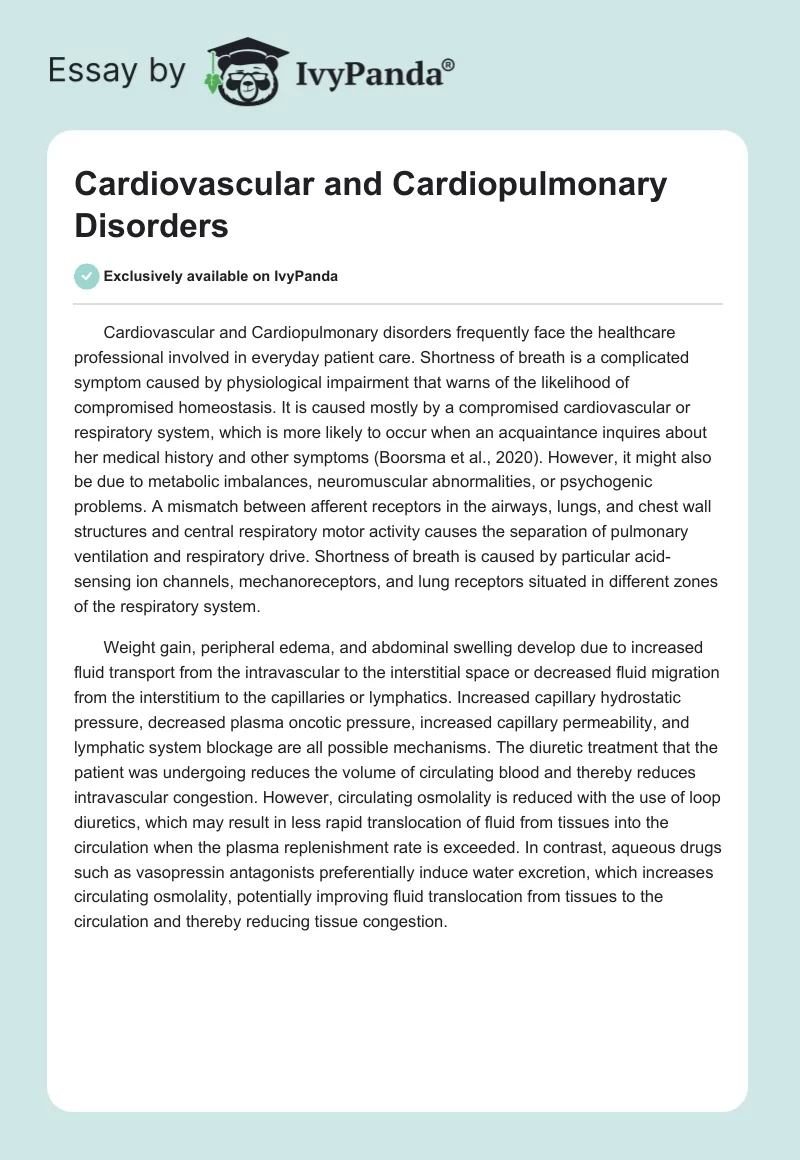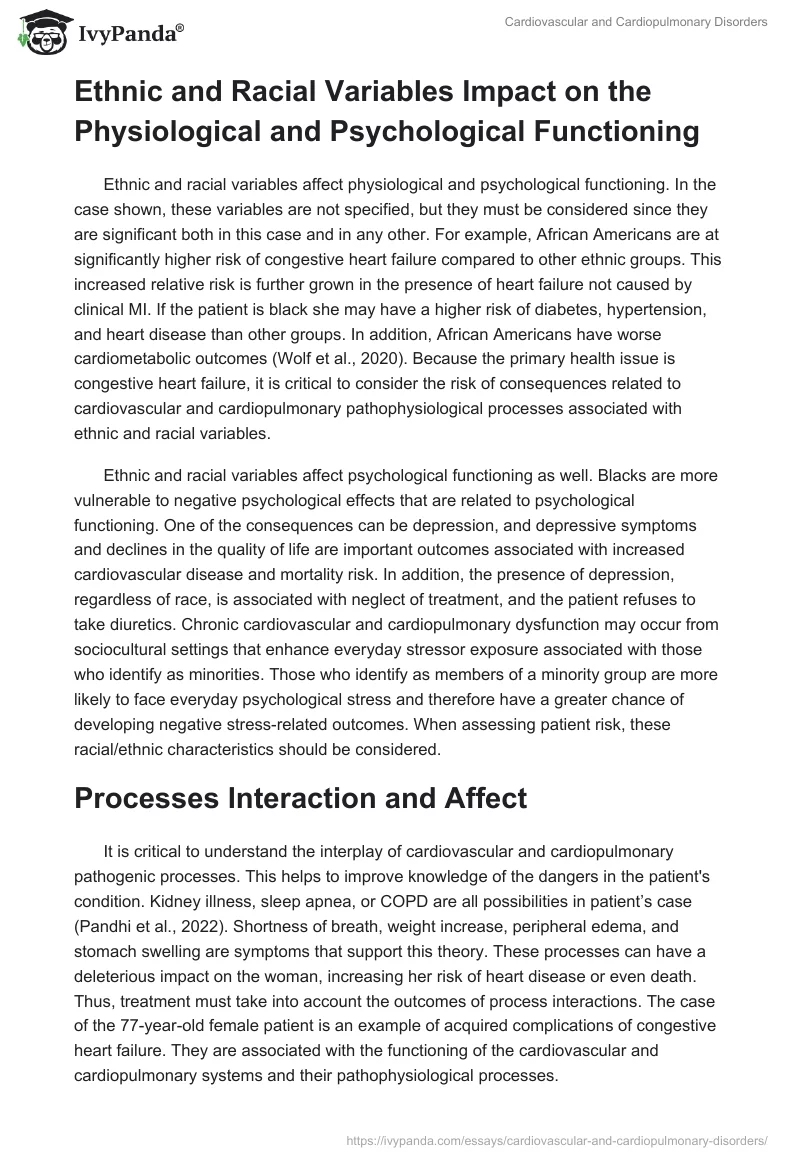Cardiovascular and Cardiopulmonary disorders frequently face the healthcare professional involved in everyday patient care. Shortness of breath is a complicated symptom caused by physiological impairment that warns of the likelihood of compromised homeostasis. It is caused mostly by a compromised cardiovascular or respiratory system, which is more likely to occur when an acquaintance inquires about her medical history and other symptoms (Boorsma et al., 2020). However, it might also be due to metabolic imbalances, neuromuscular abnormalities, or psychogenic problems. A mismatch between afferent receptors in the airways, lungs, and chest wall structures and central respiratory motor activity causes the separation of pulmonary ventilation and respiratory drive. Shortness of breath is caused by particular acid-sensing ion channels, mechanoreceptors, and lung receptors situated in different zones of the respiratory system.
Weight gain, peripheral edema, and abdominal swelling develop due to increased fluid transport from the intravascular to the interstitial space or decreased fluid migration from the interstitium to the capillaries or lymphatics. Increased capillary hydrostatic pressure, decreased plasma oncotic pressure, increased capillary permeability, and lymphatic system blockage are all possible mechanisms. The diuretic treatment that the patient was undergoing reduces the volume of circulating blood and thereby reduces intravascular congestion. However, circulating osmolality is reduced with the use of loop diuretics, which may result in less rapid translocation of fluid from tissues into the circulation when the plasma replenishment rate is exceeded. In contrast, aqueous drugs such as vasopressin antagonists preferentially induce water excretion, which increases circulating osmolality, potentially improving fluid translocation from tissues to the circulation and thereby reducing tissue congestion.
Ethnic and Racial Variables Impact on the Physiological and Psychological Functioning
Ethnic and racial variables affect physiological and psychological functioning. In the case shown, these variables are not specified, but they must be considered since they are significant both in this case and in any other. For example, African Americans are at significantly higher risk of congestive heart failure compared to other ethnic groups. This increased relative risk is further grown in the presence of heart failure not caused by clinical MI. If the patient is black she may have a higher risk of diabetes, hypertension, and heart disease than other groups. In addition, African Americans have worse cardiometabolic outcomes (Wolf et al., 2020). Because the primary health issue is congestive heart failure, it is critical to consider the risk of consequences related to cardiovascular and cardiopulmonary pathophysiological processes associated with ethnic and racial variables.
Ethnic and racial variables affect psychological functioning as well. Blacks are more vulnerable to negative psychological effects that are related to psychological functioning. One of the consequences can be depression, and depressive symptoms and declines in the quality of life are important outcomes associated with increased cardiovascular disease and mortality risk. In addition, the presence of depression, regardless of race, is associated with neglect of treatment, and the patient refuses to take diuretics. Chronic cardiovascular and cardiopulmonary dysfunction may occur from sociocultural settings that enhance everyday stressor exposure associated with those who identify as minorities. Those who identify as members of a minority group are more likely to face everyday psychological stress and therefore have a greater chance of developing negative stress-related outcomes. When assessing patient risk, these racial/ethnic characteristics should be considered.
Processes Interaction and Affect
It is critical to understand the interplay of cardiovascular and cardiopulmonary pathogenic processes. This helps to improve knowledge of the dangers in the patient’s condition. Kidney illness, sleep apnea, or COPD are all possibilities in patient’s case (Pandhi et al., 2022). Shortness of breath, weight increase, peripheral edema, and stomach swelling are symptoms that support this theory. These processes can have a deleterious impact on the woman, increasing her risk of heart disease or even death. Thus, treatment must take into account the outcomes of process interactions. The case of the 77-year-old female patient is an example of acquired complications of congestive heart failure. They are associated with the functioning of the cardiovascular and cardiopulmonary systems and their pathophysiological processes.
References
Boorsma, E., Maaten, J., Damman, K., Dinh W., Gustafsson, F., Goldsmith, S., Burkhoff, D., Zannad, F., Udelson, J. & Voors, A. (2020). Congestion in heart failure: A contemporary look at physiology, diagnosis and treatment. Nature Reviews Cardiology, 17(10), 641-655. Web.
Pandhi, P., Ter Maaten, J. M., Anker, S. D., Ng, L. L., Metra, M., Samani, N. J., Lang, C., Dickstein, K., de Boer, R., van Veldhuisen, D., Voors, A. & Sama, I. E. (2022). Pathophysiologic processes and novel biomarkers associated with congestion in heart failure. Heart Failure, 10(9), 623-632. Web.
Wolf, S. T., Jablonski, N. G., & Kenney, W. L. (2020). Examining “race” in physiology. American Journal of Physiology-Heart and Circulatory Physiology, 319(6), 1409-1413. Web.


